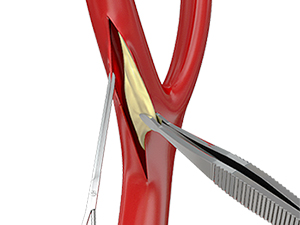Endarterectomy
 Normally, the arteries have a smooth surface inside to promote unobstructed flow of blood. With advancing age, a sticky plaque made up of cholesterol, calcium or fibrous tissue starts accumulating on the inner walls of your arteries. These plaques are called atherosclerotic plaques and the condition is termed as atherosclerosis. The deposition of plaque makes your arteries narrow and stiff. This can eventually lead to obstructed blood flow resulting in decreased oxygen supply to your organs and muscles. Endarterectomy is a surgical procedure to remove the atherosclerotic plaque from the narrowed artery. Endarterectomy minimizes the risk of complications that atherosclerosis may cause.
Normally, the arteries have a smooth surface inside to promote unobstructed flow of blood. With advancing age, a sticky plaque made up of cholesterol, calcium or fibrous tissue starts accumulating on the inner walls of your arteries. These plaques are called atherosclerotic plaques and the condition is termed as atherosclerosis. The deposition of plaque makes your arteries narrow and stiff. This can eventually lead to obstructed blood flow resulting in decreased oxygen supply to your organs and muscles. Endarterectomy is a surgical procedure to remove the atherosclerotic plaque from the narrowed artery. Endarterectomy minimizes the risk of complications that atherosclerosis may cause.
Indication
Endarterectomy is mainly performed if you have 50 to 70% narrowing of arteries. Endarterectomy has also proven to work better than medicines in people suffering from 70 to 99% blockage. This surgery is also recommended for the treatment of peripheral arterial disease, renal (kidney) artery disease, aortic arch conditions, aortoiliac occlusive disease, and visceral (intestines, spleen, and liver) artery disease.
Pre-surgical care
Your doctor may order an angiogram before the surgery. Angiogram is an invasive diagnostic test which gives a clear picture of the blood vessels. This helps your surgeon to ensure that it is safe to perform the surgery. You may be asked to discontinue some of your medicines before the surgery.
Surgical procedure
During the surgery, a small incision is made over the location of the artery to be treated and the artery is exposed. The blood flow is temporarily shunted (rerouted) with the help of a tube. The artery is cut opened and the plaque is carefully removed. A vein from the leg may be grafted onto the artery to repair the vessel. The shunt is then removed and the artery is stitched closed. The skin is finally sutured firmly. The complete surgery takes about 1 hour.
Post-surgical care
Soon after surgery, you will be moved to a recovery room for a short period of time. After this, you may be monitored in the intensive care unit for about 24 hours where you will be kept under close observation to watch development of any complications. You may be discharged after 1-3 days of hospital stay. You will be advised not to perform rigorous physical activities. There may be some pain in the area of surgery for the first 2 weeks. You can resume performing your normal daily activities within 1 or 2 weeks.
Risks & Complications
As seen with any surgical procedure, the complications that can occur due to endarterectomy are:
- Heart attack
- Stroke or transient ischemic attack
- Wound hematoma
- Intracerebral haemorrhage
- Cranial nerve deficits
- Repeated blockage of the artery
- Seizures (an uncommon complication)
- Infection
- Arrhythmias (irregular heart beat)
- Hypertension (high blood pressure)
- Airway obstruction from swelling







